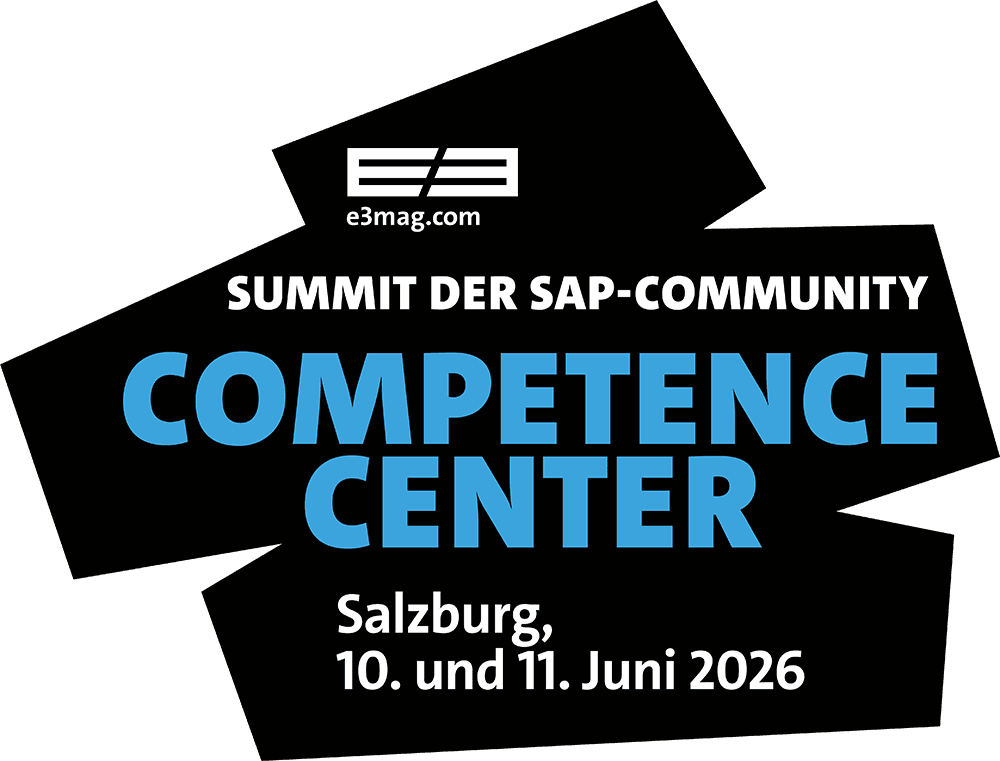SAP EWM on S/4 Hana in Focus


Warehouse logistics is constantly changing. Many organizations that previously worked with SAP WM or individual isolated solutions are faced with the decision to make the leap to SAP Extended Warehouse Management as part of the S/4 migration. EWM not only replaces the classic SAP WM, it also integrates more deeply into the supply chain processes and offers slot management, embedded lean warehouse functions and cross-docking strategies, among other things.
Modular and object-oriented
Technically, this is realized through a modular structure and object-oriented architecture as well as business objects (e.g. handling units, warehouse tasks, warehouse orders), which technically provide abstractions across tables. However, SAP EWM is also essentially based on classic SAP tables (Abap Dictionary), supplemented by Business Object Layers (BOL), persistence classes and more complex object structures. SAP EWM goes far beyond the table- and field-oriented structures of SAP WM.
The switch from SAP WM to SAP EWM also offers tangible functional and process-related benefits. A key added value lies in the significantly more precise control of warehouse processes. SAP EWM supports slotting and rearrangement, whereby storage bins are automatically assigned based on criteria such as product dimensions, movement data or consumption patterns and adjusted as required.
This ensures greater material availability while optimizing the use of space, an option that is not available in this form in the classic WM system. SAP EWM also offers extended functions in the area of picking. In addition to traditional methods, the system also supports multi-order picking using a pick cart and cross-delivery picking. External pick-by-light and pick-by-voice systems can be seamlessly connected, which significantly reduces throughput times.
SAP EWM also has integrated functions for cross-docking and yard management.
Predefined cross-docking processes and comprehensive control of gates and vehicle movements are included as standard. These processes are not mapped in this depth in classic WM. Another advantage lies in the integrated resource and personnel deployment planning. SAP EWM makes it possible to flexibly deploy warehouse personnel and vehicle resources, taking into account not only availability but also qualifications and skills profiles. Finally, SAP EWM can be fully integrated into the overarching SAP Supply Chain Execution (SCE). The SAP Business Technology Platform (SAP BTP) or systems such as SAP MII (Manufacturing Integration and Intelligence) enable close integration with solutions such as SAP Transportation Management or SAP Manufacturing Execution, so that end-to-end processes can be implemented.
Experience from customer projects shows that SAP EWM has enabled companies to achieve an average 20 to 40 percent increase in picking efficiency, 10 to 15 percent space savings and a 50 percent improvement in adherence to delivery dates, especially in combination with process digitization and automation.
S/4 not automatically SAP EWM
Another common mistake is to believe that SAP EWM is automatically and fully available with the introduction of S/4 Hana. Although Basic EWM, which is directly integrated into S/4 Hana, and Advanced EWM as an add-on provide different function packages, the features differ considerably. A detailed analysis is essential, especially in complex warehouse processes. Many IT managers underestimate the effort required to migrate data, especially historical and consolidated information from SAP WM.
Furthermore, integration into the neighboring SAP modules and the connection of any existing external systems poses a challenge. In addition, project delays often occur without a clearly defined target image and a well thought-out process architecture. S/4 Hana alone therefore does not create an efficient EWM solution - business and technical foresight is required here.
Lessons Learned
Practical experience shows that similar stumbling blocks arise time and again when implementing SAP EWM on S/4 Hana. Inadequate master data quality is a particularly frequent cause of problems. Inaccurate or outdated information about storage bins, article master data and batch details block numerous EWM functionalities from the outset. Consistent data governance is therefore essential in the run-up to implementation in order to create a stable database.
Another critical point is the lack of process documentation. In many cases, individual exceptions and manual workarounds have been established over the years in classic SAP WM that have not been systematically recorded. Anyone who simply carries out a technical system change here risks a loss of control and inefficiencies.
For this reason, it is advisable to carry out a complete process mapping before the start of the project, ideally supplemented by a decision matrix for the systematic release of processes.
The integration effort is also often underestimated. A successful EWM landscape requires a close connection to ERP systems, transport management solutions, external label systems, yard management software and IoT-based applications. Each additional interface has an impact on the implementation effort, which makes it necessary to coordinate all systems and stakeholders at an early stage.
Finally, in-house developments and customizations are also a frequent topic. Over time, many companies have implemented individual enhancements that are not always strategically necessary. It should therefore be checked which of these developments can actually be adopted or replaced by standard SAP EWM functions. Tests for reusability and portability help to keep the system landscape as lean and low-maintenance as possible.
Leogistics relies on proven change management. Customer experience shows that by consistently taking these lessons learned into account, project runtimes can be reduced by up to 15 percent and retroactive adaptation costs due to change requests can be significantly avoided. The decision as to whether SAP EWM should be operated in the private cloud, the public cloud or on-premises requires a precise analysis of the operational and technological requirements.
The right IT architecture
While the private cloud and on-premises offer extended customization options and in-depth system integration, the public cloud scores with faster release cycles and reduced operating costs. However, not all private cloud functions are immediately available in the public cloud. A systematic comparison of functional and procedural requirements is therefore essential.
In addition, the SAP Business Technology Platform (BTP) is gaining in strategic importance. It acts as a technological link for individual extensions, integrations and the use of machine learning and predictive analytics. Especially in combination with SAP EWM, the SAP BTP creates significant added value through the integration of real-time control, mobile data collection and process automation. Companies that operate SAP EWM without the integration of BTP are not fully exploiting their technological potential.
More than just a system change
The implementation of SAP EWM on S/4 Hana is much more than a technical upgrade. It represents a strategic reorientation of warehouse logistics and can only be successfully implemented with a holistic approach including process optimization, data consolidation and a technological basis. The combination of SAP EWM with SAP BTP and a clearly defined cloud strategy or on-premises solution forms the framework for a modern, resilient and adaptive supply chain that has an impact far beyond traditional automation goals.
Warehouse logistics is constantly changing. Many organizations that previously worked with SAP WM or individual isolated solutions are faced with the decision to make the leap to SAP Extended Warehouse Management as part of the S/4 migration. EWM not only replaces the classic SAP WM, it also integrates more deeply into the supply chain processes and offers slot management, embedded lean warehouse functions and cross-docking strategies, among other things.
Modular and object-oriented
Technically, this is realized through a modular structure and object-oriented architecture as well as business objects (e.g. handling units, warehouse tasks, warehouse orders), which technically provide abstractions across tables. However, SAP EWM is also essentially based on classic SAP tables (Abap Dictionary), supplemented by Business Object Layers (BOL), persistence classes and more complex object structures. SAP EWM goes far beyond the table- and field-oriented structures of SAP WM.
The switch from SAP WM to SAP EWM also offers tangible functional and process-related benefits. A key added value lies in the significantly more precise control of warehouse processes. SAP EWM supports slotting and rearrangement, whereby storage locations are automatically assigned based on criteria such as product dimensions, movement data or consumption patterns and adjusted as required. This ensures higher material availability while optimizing space utilization, an option that is not available in this form in the classic WM system. SAP EWM also offers extended functions in the area of picking.
In addition to traditional methods, the system also supports multi-order picking using a pick cart and cross-delivery picking. External pick-by-light and pick-by-voice systems can be seamlessly connected, which significantly reduces throughput times.
SAP EWM also has integrated functions for cross-docking and yard management. Predefined cross-docking processes and comprehensive control of gates and vehicle movements are included as standard. These processes are not mapped in this depth in classic WM. Another advantage lies in the integrated resource and personnel deployment planning. SAP EWM makes it possible to flexibly deploy warehouse personnel and vehicle resources, taking into account not only availability but also qualifications and skills profiles.
Finally, SAP EWM can be fully integrated into the overarching SAP Supply Chain Execution (SCE). The SAP Business Technology Platform (SAP BTP) or systems such as SAP MII (Manufacturing Integration and Intelligence) enable close integration with solutions such as SAP Transportation Management or SAP Manufacturing Execution, so that end-to-end processes can be implemented.
Experience from customer projects shows that SAP EWM has enabled companies to achieve an average 20 to 40 percent increase in picking efficiency, 10 to 15 percent space savings and a 50 percent improvement in adherence to delivery dates, especially in combination with process digitization and automation.
S/4 not automatically SAP EWM
Another common mistake is to believe that the introduction of
S/4 Hana SAP EWM is automatically and fully available. Although different function packages are available with Basic EWM, which is directly integrated into S/4 Hana, and Advanced EWM as an add-on, the features differ considerably. A detailed analysis is essential, especially in complex warehouse processes.
Many IT managers underestimate the effort involved in migrating data, especially historical and consolidated information from SAP WM. Furthermore, integration into neighboring SAP modules and the connection of any existing external systems is a challenge. In addition, project delays often occur without a clearly defined target image and a well thought-out process architecture. S/4 Hana alone therefore does not create an efficient EWM solution - business and technical foresight is required here.
Lessons Learned
Practical experience shows that similar stumbling blocks arise time and again when implementing SAP EWM on S/4 Hana. Inadequate master data quality is a particularly frequent cause of problems. Inaccurate or outdated information about storage bins, article master data and batch details block numerous EWM functionalities from the outset. Consistent data governance is therefore essential in the run-up to implementation in order to create a stable database.
Another critical point is the lack of process documentation. In many cases, individual exceptions and manual workarounds have been established over the years in classic SAP WM that have not been systematically recorded. Anyone who simply carries out a technical system change here risks a loss of control and inefficiencies.
For this reason, it is advisable to carry out a complete process mapping before the start of the project, ideally supplemented by a decision matrix for the systematic release of processes.
The integration effort is also often underestimated. A successful EWM landscape requires a close connection to ERP systems, transport management solutions, external label systems, yard management software and IoT-based applications. Each additional interface has an impact on the implementation effort, which makes it necessary to coordinate all systems and stakeholders at an early stage. Finally, in-house developments and customizations are also a frequent topic. Many companies have implemented individual extensions over time that are not always strategically necessary. It should therefore be checked which of these developments can actually be adopted or replaced by standard SAP EWM functions. Tests for reusability and portability help to keep the system landscape as lean and low-maintenance as possible.
Leogistics relies on proven change management. Customer experience shows that by consistently taking these lessons learned into account, project runtimes can be reduced by up to 15 percent and retroactive adaptation costs due to change requests can be significantly avoided. The decision as to whether SAP EWM should be operated in the private cloud, the public cloud or on-premises requires a precise analysis of the operational and technological requirements.
The right IT architecture
While the private cloud and on-premises offer extended customization options and in-depth system integration, the public cloud scores with faster release cycles and reduced operating costs. However, not all private cloud functions are immediately available in the public cloud. A systematic comparison of functional and process-related requirements is therefore essential. In addition, the SAP Business Technology Platform (BTP) is gaining in strategic importance.
It acts as a technological link for individual extensions, integrations and the use of machine learning and predictive analytics. Especially in combination with SAP EWM, SAP BTP creates significant added value through the integration of real-time control, mobile data collection and process automation. Companies that operate SAP EWM without the integration of BTP are not fully exploiting their technological potential.
More than just a system change
The implementation of SAP EWM on S/4 Hana is much more than a technical upgrade. It represents a strategic reorientation of warehouse logistics and can only be successfully implemented with a holistic approach including process optimization, data consolidation and a technological basis. The combination of SAP EWM with SAP BTP and a clearly defined cloud strategy or on-premises solution forms the framework for a modern, resilient and adaptive supply chain that has an impact far beyond traditional automation goals.




